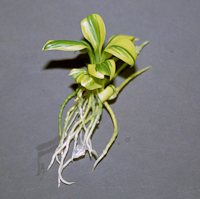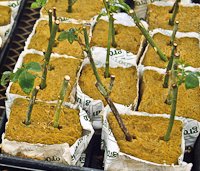 One of the things that
used to be unique to plants was that you could produce a
whole new plant from a piece of the original plant. Of
course, in recent years, it has been discovered that
even animals can be reproduced this way. Oh, well.
One of the things that
used to be unique to plants was that you could produce a
whole new plant from a piece of the original plant. Of
course, in recent years, it has been discovered that
even animals can be reproduced this way. Oh, well.
Perhaps the most common
method of propagating landscape plants is by taking
cuttings. It can be as simple as lopping a leaf off a
plant, sticking it into a moist media and, presto, roots
appear. However, all (perhaps most) plants don't respond
so easily. That is why several different types of
cuttings have been developed.
The key challenge to
success with cuttings is to keep them from drying out.
Care must be taken to keep them in a moist environment
at all times during the process. This can be easy in
some cases but more difficult (and expensive) in others.
 Roots form on stems,
leaves and other plant parts as a result of
hormone
activity. Again, there is a wide range of responses in
the plant world. Some cuttings will take root just by
being stuck in a moist media. Others will need to be
supplemented by the application of one of many different
plant hormones used to stimulate root growth. In tough
cases, varies mixtures and strengths of rooting hormones
must be devised for successful rooting to occur. For
more on rooting
hormones used in propagation...
Roots form on stems,
leaves and other plant parts as a result of
hormone
activity. Again, there is a wide range of responses in
the plant world. Some cuttings will take root just by
being stuck in a moist media. Others will need to be
supplemented by the application of one of many different
plant hormones used to stimulate root growth. In tough
cases, varies mixtures and strengths of rooting hormones
must be devised for successful rooting to occur. For
more on rooting
hormones used in propagation...
Taking cuttings is an
asexual method of reproduction. Therefore, the plants
produced by this method are genetically exactly the same
as the original plant, also known as a clone. This is
why such plants, if they are a named cultivar, will be
"true to type" and may keep the same name. When you buy
a
Phlox 'White Admiral' that was reproduced by
root cuttings, you can be assured that it will have
exactly the same characteristics as the mother plant.



